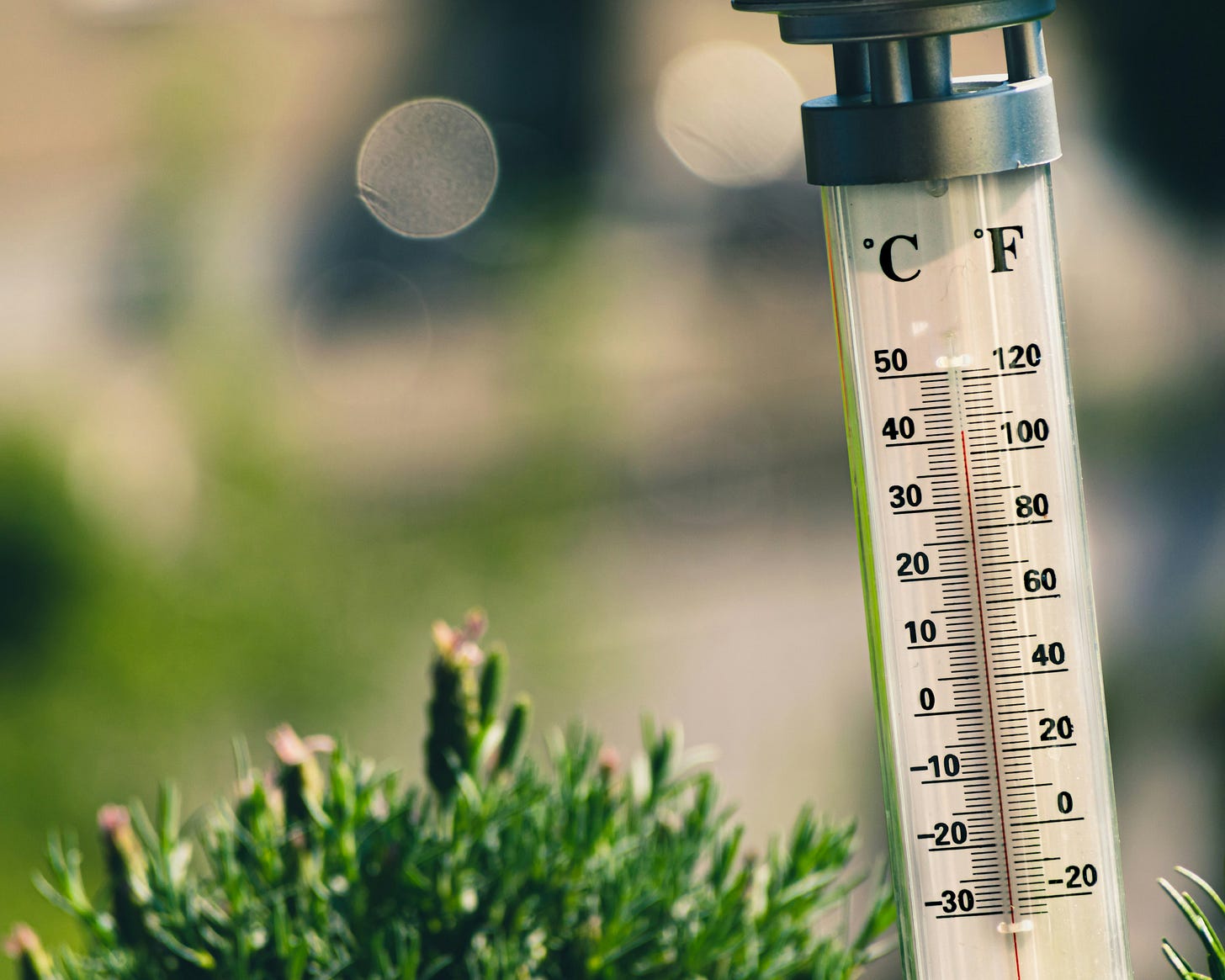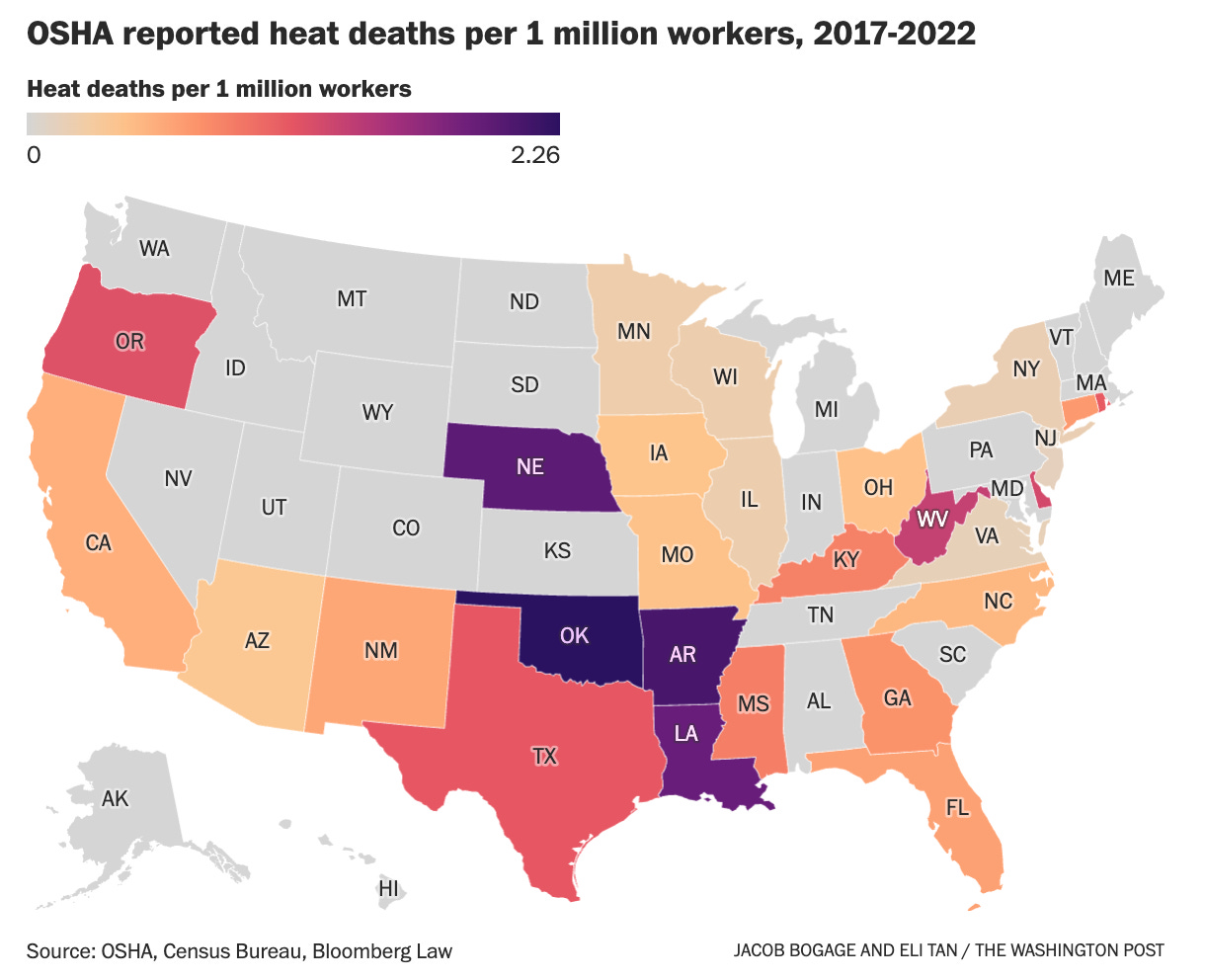How Extreme Heat Impacts Worker Productivity
Find out how this sizzling summer shapes our work and our wallets.
Thank you for reading Monday Morning Economist! This is a free weekly newsletter that explores the economics behind pop culture and current events. This newsletter lands in the inbox of thoussands of subscribers every week! You can support this newsletter by sharing this free post or becoming a paid supporter:

As the summer sun blazes over the United States, nearly a third of the country has been sweltering under a massive heatwave. These dangerous temperatures are more than just a sweaty inconvenience. They’re a serious issue that’s here to stay.
You might have noticed that these extreme weather events are becoming more frequent and intense. This isn’t some distant future problem. The economic consequences of our current heatwave give us a preview of what might be our new normal.
Right now, this heatwave is breaking records, putting a strain on our power grids, and sending temperatures skyrocketing past what most of us can handle. But there’s more to it than just feeling uncomfortable and worrying about heatstroke. Extreme heat takes a serious toll on worker productivity, which in turn affects our entire economy.

The Impact on Outdoor Workers (The Seen)
Let’s start with the people who feel the heat the most: outdoor workers. It’s the folks working in agriculture, construction, or delivery services. These jobs involve spending long hours under the blazing sun, and it’s no surprise that the heat takes a serious toll on them.
First off, there’s the physiological stress. Working in extreme heat reduces both physical and cognitive performance, which means people get tired faster and can’t think as clearly. This increases the risk of heat-related illnesses like heat exhaustion or heatstroke. They don’t just feel lousy. This level of heat is associated with more accidents and injuries on the job.
How much of an impact does extreme heat make? According to the International Labour Organization, temperatures above 75-79°F are linked to reduced productivity for individual workers. At even higher temperatures (above 91-93°F), individual productivity can drop by as much as 50% in moderately physical jobs.
Because workers need more breaks, they move more slowly, and the heat physically limits what they can do. This is especially tough for agricultural workers who are already doing physically demanding work. Imagine trying to pick crops or tend to fields when it’s scorching hot. That’s a dangerous combination.

The Impact on Indoor Workers (The Unseen)
Now let’s shift our focus indoors. It’s easy to understand how outdoor workers suffer in the heat, but indoor workers aren’t exactly off the hook. Air conditioning helps alleviate the problem, but it’s less reliable than you might realize. Many workplaces have poor ventilation or inadequate cooling, turning them into stuffy, uncomfortable environments.
Indoor temperatures also have a big impact on how well we think and work. For every 1°C increase in temperatures above 22°C (72°F), productivity drops by approximately 2%. So, even a small increase in temperature can make a big difference in how efficiently we work. This is a major issue in places without good climate control. Think older office buildings, warehouses, and factories.
When it’s too hot inside, workflows get disrupted, errors become more common, and sometimes, operations even have to shut down temporarily. Whether you’re in an office or a warehouse, the heat is a serious concern. It might be less visible than the impact on outdoor workers, but it’s just as important. Drops in productivity compound, affecting businesses and the economy as a whole.
Economic Output: The Broader Implications
Let’s zoom out a bit and look at the broader economic picture. When workers are less productive because of extreme heat, it affects the entire economy. When productivity drops, the output of goods and services declines, and this is felt across various sectors. It doesn’t mean we’ll have a full-blown recession, but it can cause slower economic growth and higher costs for everyone.
Short-Term Economic Impacts:
To start, businesses face increased operational costs. They will spend more on cooling their spaces, providing hydration and rest stations, and covering medical expenses for heat-related health issues. When workers can’t perform at their best, especially in heat-sensitive industries like agriculture and construction, there are delays in projects, drops in yields, and disruptions in supply chains. These issues create a ripple effect that impacts the availability of products and services.
A recent study found that high heat costs the U.S. economy a staggering $100 billion each year in lost productivity. And this figure doesn’t even account for other heat-related impacts, like decreased tourism and rising health and energy costs. It doesn’t appear to be getting better anytime soon. Those losses are projected to double by 2030!
Long-Term Economic Impacts:
Over time, the health costs associated with heat-related illnesses start to pile up. Both individuals and the public health system bear these costs, but the labor market isn’t immune. Extreme heat can lead to higher absenteeism and turnover rates as workers struggle to cope with the conditions. Employers end up spending more money on recruitment and training.
Extreme heat has a significant impact on our economy, both in the short term and the long term. Businesses, workers, and consumers all feel the heat, literally and financially.
A study by researchers at the Federal Reserve Bank of Richmond found that rising summer temperatures are linked to a drop in gross state product (GSP), which measures the value added in production by labor and capital in each state. The researchers found that for every 1°F increase in average summer temperature, the annual GSP growth rate declines by 0.154 percentage points. It may seem like a small dip in output, but reductions in the growth rate have long-term implications since growth rate changes compound over time.
Final Thoughts
The current heatwave is a stark reminder of the growing challenges posed by climate change. But how can policymakers and businesses tackle the economic impact of extreme heat? This requires planning for a future where these heatwaves might become the norm. As extreme heat events become more frequent and intense, their impact on worker productivity and economic output will only increase if we don’t change how we respond.
Federal law requires employers to protect workers from the dangers of heat exposure and to have a proper safety and health plan in place. At a minimum, this means providing adequate cool water, rest breaks, and shade or a cool rest area. While some states may be slow to implement policies, local governments have taken steps to protect workers from the elements. However, states like Florida and Texas have even limited the power of local governments to require heat and water breaks for outdoor workers.
In the end, addressing the economic consequences of extreme heat requires that we prepare for a future where such events are the norm rather than the exception. Thoughtful policy and innovative business practices can help workers navigate this dangerous environment and help ensure a productive and resilient economy.
Record highs (years) were set at the Atlantic City Airport (1988), Philadelphia (1888), and Reading (1908) as all 3 reached 98° over the weekend [National Weather Service Mount Holly]
Around the globe, 1,400 temperature records were broken across five continents last week [The Washington Post]
By mid-century, the number of days per year with a heat index above 100°F could more than double [Union of Concerned Scientists]
From 1998 to 2017, more than 166,000 people have died around the world due to heatwaves [World Health Organization]
In a study of the impact of heat on students, schools without air conditioning saw a 1% reduction in learning when the school year was 1°F hotter [American Economic Journal: Economic Policy]







Another dimension heat may be important inequality as was shown in the case of tennis players. Top tennis players who are wealthier can deal with heat better with post match treatments. Something which is currently too costly for poorer tennis players.
Funny you mention cognitive performance ... saw this the other day:
https://www.insidenova.com/do-politicians-get-dumber-in-the-heat-study-reveals-the-answer/article_6c6a795b-e010-5122-ba8e-fa60df46dd39.html